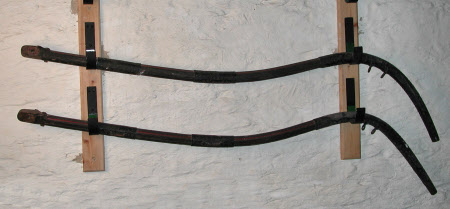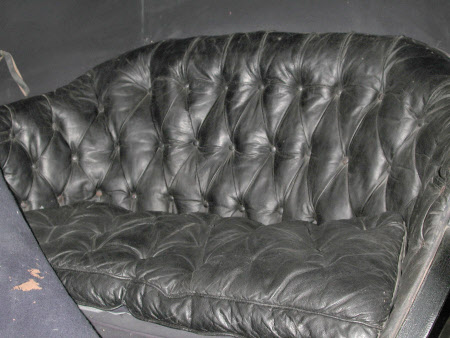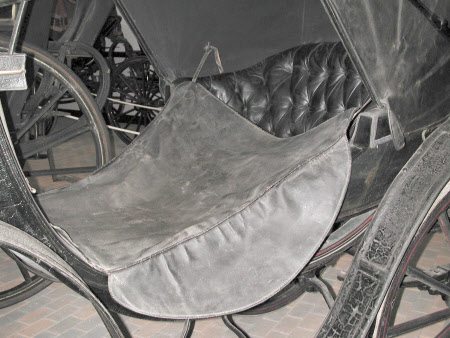Victoria
Category
Carriages & other vehicles
Date
1903
Materials
Leather, Linoleum, Rubber, Textile, Wood
Measurements
2100 x 1700 mm; 3300 mm (Length)7 cwt (Wt)
Order this imageCollection
National Trust Carriage Museum
NT 272903
Summary
Victoria built for Lord Stanhope by Pfiel Stedall & Son in 1903.
Full description
Panel Boot Victoria with skeleton lower quarters and curved bottom line from back of body to the footboard. No occasional seat and fixed heelboard. Single seat rails to coachman’s seat. Head on single straight joints. On full elliptic springs. In black livery with red lining and Stanhope cypher on both side and rear panels, and black leather interior trim. With one leather buttoned cushion and detachable leather apron. This carriage was built in the early 1900s and was a gift from the Trustees of the Chevening Estate, Kent. It has been fully conserved. It belonged to Lord Stanhope and is painted in his colours. It could be driven to either a single horse, when shafts would be fitted, or a pair, which need a splinter bar and a pole. Victorias are open carriages, driven by a coachman with a footman sitting next to him. The low comfortable body carries two, or occasionally three if it has a folding seat stowed in the back of the boot. The low access, elegant style and comfortable seating made the Victoria very popular with ladies for fine weather use. CJN 12.11.07 Steps Stirrup style jagged plate step with leather toe piece each side. Ribbed treads on outer stock hoops of front wheels. Oval jagged plate treads on outer roller bolts. Lamps Lamp irons bolted to underside of coachman’s seat board. No lamps. External Furniture Silver-plated external furniture CARRIAGE Wheels Twelve and fourteen spoke Warner wheels with ½ rims. Wired-on grey rubber tyres. Axles Collinge’s patent axles – straight Springs Elliptic springs front and back, both springs bolted to axle bed and clipped to axles Fore carriage Open futchell fore carriage with compassed transom and axle bed. Elliptical carved fiddle ends with dragon tongue bolts with leather rat tails. Compassed iron horn bar, full wheel plate and sway bar. Front floor supported on foliage scroll blocks on transom. splinter bar, shafts, pole missing. Shafts with iron tips, tug stops (beneath shaft) and breeching staples Hind carriage Pump handles with moulded wood capping with angular parallelogram fiddle ends. Waisted hind axle bed Brake Lever-action break with wood blocks. Hand lever nicely reflects the profile of the underside of the body. Leather served handle. Rack bolted to top of coachman’s seat board. Paint Black with fine red line on body frame mouldings. Medium red line and two fine red lines on wheels and springs, mouldings and carvings picked out red to match Heraldry Monogram on ¼ panels and back panel – interlocked ‘S’ motif surmounted by an Earl’s coronet Leather Leather head with welted leather valance leather wings, step toe-piece, apron with straps on back of boot. Welted leather coachman’s seat valance. Leather served seat rails and brackets. Leather dashboard, roller bolt leathers and shaft leathers all enamelled leather External Trimming Blue cloth coachman seat fall, cushion missing. Floor cloth on front floor and footboard, blue flowers on black ground Internal Trimming Curved combined back and ¼ squabs, deep buttoned black morocco with morocco covered buttons. Similar cushion with wool tufts and straight back (should be curved). Pleated navy blue wool seat fall with broad lace edging with worsted geometric figure on worsted ground. Brussels carpet on sides of footwell and on heelboard main carpet missing. Floorcloth on floor – same as front floor. Blue wool cloth lining to apron
Provenance
Property of the late Lord Stanhope



